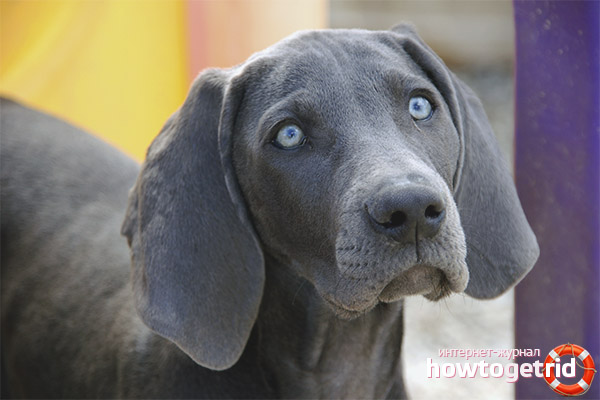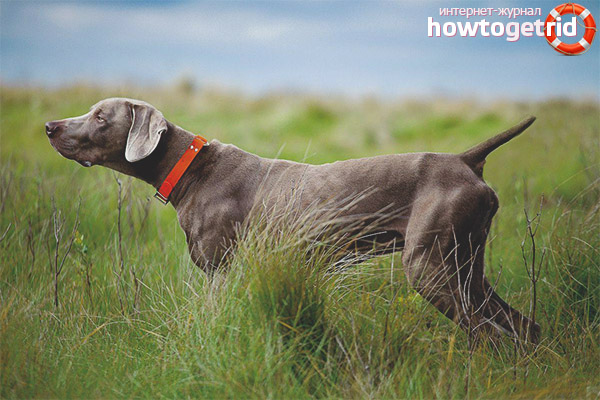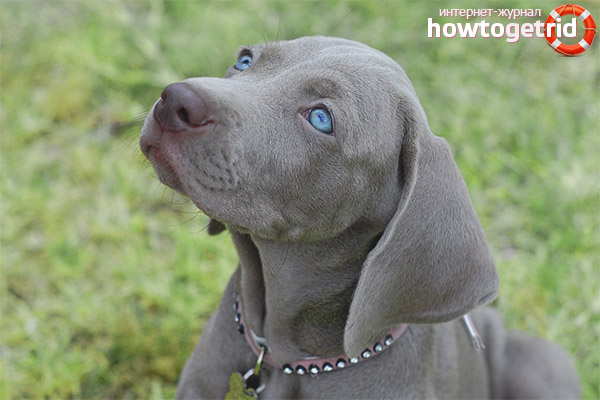The content of the article
The Weimaraner, or Weimar Pointing Dog, is a hunting, dog-friendly breed of dog of German origin. The hunting group to which this breed belongs is the Continental Pointing Dog.
Performance data
The representatives of the upper and lower flair are equally well developed, due to this this breed is a very valuable and prey hunter. With the help of the upper instinct, the Weimaraner can easily search for game, even in adverse weather conditions, including during a strong wind, and thanks to the lower instinct, it perfectly takes a trace. If the prey was wounded, for this dog it will not be difficult to find it on a bloody trail.
The owners of this breed are preferably hunters, since it is the hunters who can appreciate all the positive qualities of the Weimaraner, such as excellent sense of smell, reliability and devotion to their master. This breed of dog is generally used when hunting for wild birds, for example, snipe, corncrake, duck, partridge, quail. Weimar Pointing Dog is also suitable for hunting a hare or fox.
In addition to its hunting purpose, this dog has established itself as an excellent search engine and companion. She will be incredibly kind, loving and faithful, if treated with respect and care. The dog has a stable psyche and flexible, calm character. It is due to such an abundance of positive qualities that the Weimar Pointing Dog is considered an almost universal breed of dog, which, moreover, does not need any special care.
On our open spaces, many even have no idea that such a breed of dog exists, despite the fact that among hunters, weimaraners enjoy great respect and love. The Weimar Pointing Dog is a very kind, lively and cheerful dog, treats young children well, and therefore can become a wonderful member of an active and positive family.
Appearance
- The Weimar Pointing Dog is a rather large dog, it has a well-developed skeleton and muscles, general growth parameters vary from 60-70 cm, can weigh from 25 to 40 kg.
- This breed has two varieties of wool, may be long-haired or short-haired. The long coat of weimaraner is soft and pleasant to the touch, has a slightly pronounced undercoat, tow is present in the ears, abdomen, chest, and tail. In short-haired breed, the hairline is quite thick, shiny, very tightly attached to the body, it does not have a pronounced undercoat. However, there are weimaraners whose coat is of the third, mixed type. The coat of such dogs is quite thick, has moderate tows and medium length.
- The color of the woolen color of the Weimar Pointing Dog is exclusively gray, from pale ashen to dark gray. It is noteworthy that the head and ears are several tones lighter in color than the entire body and legs, and quite often, a slightly noticeable, dark gray strip can pass through the entire back. Weimaraner can sometimes be found with small white marks on the legs and chest.
- The Weimar Pointing Dog has a dry head, there is a pronounced groove on it, which runs along the entire, non-convex forehead. Cheekbones pronounced and distinct, elongated muzzle shape. The shape of the eyes is round, the color of the iris in an adult dog is exclusively dark or light amber shades.For puppies of this breed, a blue shade of the iris is characteristic, which changes color as it grows older. The appearance of the Weimar Pointing Dog is quite pleasant, the nose has a slightly convex back and a large lobe, preferably gray-brown shades. The location of the ears is very peculiar, which is explained by the purpose of the breed, they are set rather high and rush forward, of medium width and always hang down.
- The neck of this dog, like the head, is dry and muscular, all muscles are clearly expressed, and the wide base of the neck smoothly flows into the proudly set withers.
- The size of the chest is quite wide, it looks massive.
- Weimaraners have a fairly extended back, which is characterized by a noticeable slope in the region of the croup.
- When the dog is in a calm state, its tail rushes to the bottom.
- It has bony straight legs, on which the muscles are quite well developed, due to the nature and purpose of the breed.
Breed history
The Weimar Pointing breed was recognized in 1896 in Germany. It is noteworthy that the widespread use of dogs, which were very similar in appearance to modern Weimaraners, began in the 17th century. They were popular among hunters, because thanks to their exceptional capabilities, they helped well in the process of hunting for wild birds. However, to date, reliable information is unknown regarding the occurrence of the Weimar Pointing breed.
There are several official versions of how exactly these dogs appeared. The first version is that the Duke Karl August Saxe-Weimar-Eisenach brought this breed of dog to Germany from the Czech Republic. The consonant second version of the Weimaraner is a descendant of the breeding breed, which is also a hunting dog and has lived in Germany for more than a century. In past centuries, the Weimar Pointing Dog was actively involved in the process of hunting for a large beast. The story is full of facts about how this breed was effectively used when fishing for wild boar, roe deer and even a bear.
Weimar Pointing Character
The Weimar Pointing Dog belongs to the breed of dogs that have a wonderful, kind and complaisant character. Of course, like every rational living creature, this breed at times can show its temper, despite its sincerity and good nature. Most often, this can be expressed in actions contrary to their master, that is, from the opposite.
This dog is quite open, and therefore quickly enough can become attached both to its immediate owner and to its entire family. The Weimar Pointing Dogs are especially good with trepidation and care for children. If before the appearance of this dog in the family there was already any pet, the weimaraner perceives it rather loyally. In the case when an additional animal appears in the house where the weimaraner already lives, the latter can react absolutely calmly to it, but only when the owner initially taught the dog the correct behavior.
If the dog began to make an outing into nature with the owner at an early age, and especially in hunting, she has a well-developed special instinct and distrust of strangers. This breed is always incredibly attached to its owner, such a dog is sensitive and affectionate, and spending time next to its owner gives it great pleasure.
Due to the fact that the Weimar Pointing Dog is a rather active dog, the best option for her to live is a private house, best of all outside the city, because in such conditions she will be able to run and frolic every day exactly as much as her body needs.To start this breed is not desirable for those people who are not able to devote a lot of time to it. This is explained by the fact that the weimaraner belongs to those dog breeds that are strongly attached to their master on an emotional level. The Weimar Pointing Dog endures separation and misses its owner very much.
Since this breed in its temperament is a very playful and active dog, in the case of a long stay in a limited space, for example, half a day in the house, torn things, damaged furniture and bitten household items, the owner will not be able to avoid. The thing is that the main purpose of the Weimaraner is hunting, this breed was bred for this purpose. Therefore, it is not surprising that with a long absence of room for maneuvers, she will hunt for everything that catches her eye.
Weimar Pointing Dog is a dog with a fairly good level of intelligence, she is smart and quick-witted. What is noteworthy, this breed of dog is not at all aggressive in calm domestic conditions, and it keeps on hunting calmly and nobly, even when pursuing prey. Mindless barking is not inherent in her, if she gives a voice, it is exclusively on the merits. All this once again proves that the Weimar Pointing Dog will become a wonderful friend and devoted hunter for his master, and will bring him great pleasure.
Keeping and caring for a dog
This breed of dog is in need of long walks, and certainly several times a day. It should also be borne in mind that a walk with such a dog should be not only long, but also fascinating for her, because just walking for several hours in the park is absolutely not what this animal needs. The best option for hanging out with a Weimar gundog is to teach her to perform several disciplines that can be useful not only during a walk, but also on a supposed hunt, for example, agility or frisbee. Due to the fact that this breed is very freedom-loving and active, weimaraner simply will not be able to sit in one place in a confined space for a long time.
Another distinctive feature, which is due to the dog’s affection for its owner, is that the Weimaraner is difficult to tolerate separate living from the owner. Therefore, living such a dog in an aviary or booth, as well as restricting access to housing, is highly discouraged. If she lives outside the house and has little contact with her owner, apathy in her behavior, as well as refusal to execute commands, are not excluded. Thus, the dog can express his protest about the place of his residence, or not perception of the owner as such. Aggression in the behavior of the Weimar Pointing Dog is quite rare, which in turn means that it would be inappropriate to start it to guard the house. However, if there is any threat to her or her master, she may well act as a defender.
Caring for such dogs is relatively easy, since this does not require regular special procedures; it is enough to comb out the wool once a week. It is recommended to bathe the Weimar Pointing Dog several times a year, two or three, at the discretion of the owner. Upon returning from a walk, a pet will only need to wipe its paws.
Once or twice a week, the Weimaraner must carry out cleaning of the ears, you should also adhere to oral hygiene in the form of daily brushing of teeth, several times a month to perform clipping.
You can feed both natural food and ready-made dry food.If the second option is chosen, it is necessary to take a responsible approach to the choice of food and not feed the dog cheap food with an incomprehensible composition, as this will negatively affect the further health of the pet. It is strictly forbidden to feed the animal with the food that the owner eats in everyday life. This is due to the fact that it can be too oily or seasoned with various spices, which can harm the dog's body. Sweets also do not bring any benefit to the dog.
Training and training
This breed responds well to training, in the case when the owner begins to practice it with the dog at an early age. So that the commands are successfully mastered and executed by the dog, excessive overload and pointing tone should be avoided. If the Weimar Pointing Dog is meant as a companion, in order to give her upbringing and obedience, it will be enough to go through a general training course.
When it is planned to use the dog for its intended purpose, for hunting purposes, to reach the age of 4-5 months, during an outing in nature, you should take it with you. The Weimaraner must be accustomed to hunting from a very young age so that he can gradually delve into all the subtleties of this matter. Also, for the effective participation of the Weimar Pointing Dog in the hunting process, the owner needs to calculate the optimal daily load for the dog, any dog sport is not excluded.
Health and Disease
The life expectancy of the Weimaraner is 10-12 years. The main role in the life of this dog is played by timely vaccinations and the prevention of various diseases.
The owner needs to carefully monitor the appearance of such dangerous signs of the disease as: temperature jump in the animal, upset stomach, a change in gait, the appearance of secretions from the mucous membranes of the nose or eyes. Self-treatment of the animal is strictly prohibited. In case of any suspicious symptoms, you should immediately contact your veterinarian. In addition, it is necessary to periodically undergo a preventive examination of the dog in order to establish an overall assessment of its health status. In order to provide first aid to a pet, a veterinary first aid kit should be kept at home.
This breed does not have a predisposition to any specific diseases, on the contrary, it is distinguished by its resistance and good immunity. However, with age due to increased mobility and physical activity, the appearance of hip dysplasia is not ruled out. Allergic reactions, demodicoses, dermatitis, eye diseases in the form of cataracts, corneal atrophy, and dystychiasis are also common.
Video: Weimaraner dog breed













Submit